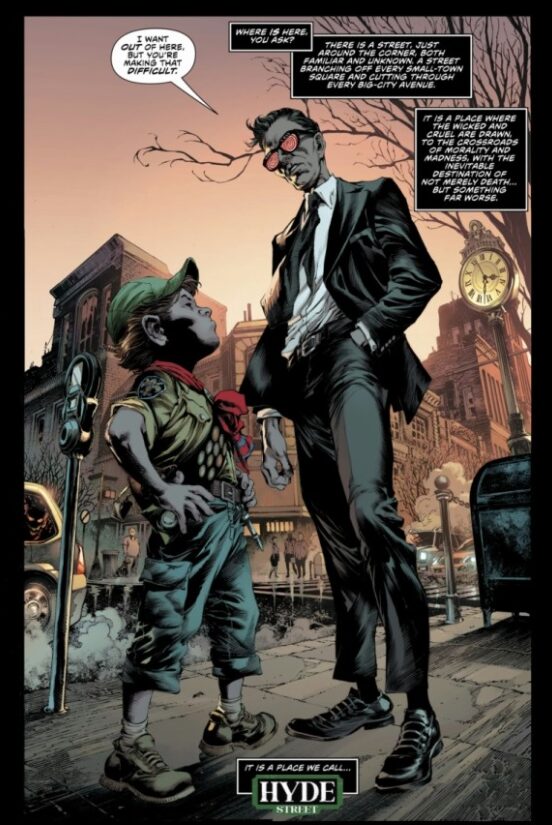
So, who are the people in your neighborhood? Personally, hearing this phrase brings up the memory of Bob McGrath singing as he took a stroll down Sesame Street. Along his stroll he would greet various Anything Muppets, each of whose occupation was identifiable by their attire. This is like the “Residents” of Ghost Machine’s Hyde Street who also employ unique methods to achieve their goal. Image Comics’ new series makes it clear that what you do matters and someone is always keeping score.
Hyde Street #1
Storytellers: Geoff Johns & Ivan Reis
Inker: Danny Miki
Letterer: Rob Leigh
Hyde Street #1 starts with the illusion of a wholesome scene. An sweet elderly woman carrying groceries struggles to locate her car due to road construction that just came out of nowhere. Suddenly, a boy in a scout uniform appears, offering to carry the heavy groceries and help her cross the detour safely. Unfortunately, her guide has a problem with kid killers. So after getting the lady to admit what’s really in her bag – the memory of the arsenic she used to poison both her husband and daughter – Pranky leaves her fate to the professionals, in this case a steamroller driver. A gleeful Pranky is too busy admiring his new “badge” to notice the story’s “hero”, Mr. X-Ray, until he walks right into him. Of course, this isn’t the first run-in between these two on Hyde Street – a place where the wicked and cruel are drawn.

So far Ghost Machine, the creator owned lineup from Image Comics, has offered readers two sides of its Universe. On one end we’ve learned through some historical revisions the horrific intentions of the United States founders in Redcoat. The other side features the monstrous future(s) awaiting mankind in Rook Exodus and Geiger. With Hyde Street, storytellers Geoff Johns and Ivan Reis establish a setting somewhere in the middle; someplace closer to home. That doesn’t just mean in the spatial sense, but also centering around the human soul. Consider Hyde Street a crossroad, a stretch of asphalt that extends across space, time and even reality. A street that intersects with every other avenue, block or cul-de-sac in existence but only leads to one final destination – damnation.
After the opening, the narration and much of this initial issue’s story comes from Mr. X-Ray, once known as Frederick Xavier Ray. With a beaming smile and curly black hair, inker Danny Miki’s Mr. X-Ray is almost a mirror image of Bob. Along with his good natured approach to everyone else on Hyde Street, Fred isn’t a completely bad neighbor. But, Mr. X-Ray’s backstory makes it clear that like all the souls residing on Hyde Street, even he was a morally compromised individual during his time on Earth.
Despite his business partner Jim’s warning against selling mail order junk to kids, Frederick followed his mentor’s business mantra – sell them what they want to believe. This carries over to how Hyde Street operates in existence, which is similar to the killer from the Wes Craven franchise. However, causing hallucinations where fantasy and reality cross paths is apparently where the intersection ends. According to Mr. X-Ray, Hyde Street isn’t a one way road.

Hyde Street #1 turns to the classic tale of Dr Jekyll by highlighting that appearances are deceiving. Frederick Rays shows this to the audience as he reminds Jim of the skeletons in his closet. Here, colorist Brad Anderson turns the otherwise vivid issue colorless. This foreshadows what eventually becomes Mr. X-Ray’s influencing tactic on those using Hyde Street as a shortcut. Like Pranky’s pranks this lays the foundation of each ‘resident’ using the “skills” that led them to Hyde Street on its many unsuspecting visitors. Observant readers will notice this includes the small teasers of other “residents” Dr. Ego and Miss Goodbody.
But Hyde Street #1 also recognizes the dual nature of mankind. Would Pranky’s callousness and cruelty run into a conflict with his conscious if he is confronted with a child visitor? Meanwhile, Mr. X-Ray looks as likely to help a soul escape as he is to send others straight to Hell. Even at the expense of his own eternal soul. A soul that had no problem disappointing thousands of American children with his products. Products like Sea Monkey, which coincidentally were not only marketed in mail order catalogs but also in comic books.
Welcome to Hyde Street, where the monster isn’t only at the end of the book. One may also live in a house at the end of the block.
Score: 9.3

